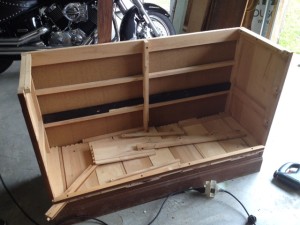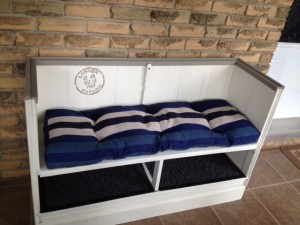Months ago, my sister-in-law Carolyn shared a post on my Facebook page about a Pinterest project. Someone had taken an old, wooden dresser and turned it into a bench. Carolyn had an old dresser that had been in the family for decades. It used to belong to our husbands’ maternal Grandma and it had seen better days. Carolyn suggested, half-joking I’m sure, that hubby and I take this on. We leapt at the chance! Once we ascertained that the dresser was indeed made of solid wood, we got to work, and kept at it when we had time.
Derek was project engineer and I was the designer. He removed the drawers and quickly realized that the supporting wood inside the structure wasn’t in a good place for a bench seat. It would either be too high or too low. So he removed that wood and created a whole new support system for a seat. First, he repurposed wood from the drawers to finish the inside and the bottom shelf where two shoe cubbies were to go.
Once it was structurally sound, finished inside and trimmed with molding, I went to work with cream-coloured chalk paint. I had consulted Carolyn on her likes and dislikes in fabric and colours. A stencil I’d loved but never used seemed perfect for this rustic repurposing job. It looks like an old stamp from something put in the mail in London in 1967. I practised it on the back before putting it on the front in grey.
Good quality fabric is expensive so when I found a huge lounge cushion at Loblaws for $19 that was in Carolyn’s preferred colour scheme, I grabbed it. A friend’s neighbour sews anything and everything, and she made a smaller cushion for the seat out of it.There’s a ton of fabric and stuffing left over if we ever need it.
I waxed the whole thing for a little resilience, cut floor mats to size for the cubbies and we took it to its new home on Friday. It now sits in the entryway to their home, which is a narrow sunroom that runs the length of the front of the house.
On the back, I affixed a little typed explanation of what this piece once was and who it belonged to. In case it gets shuffled around in the future, we want the younger generations to know it’s part of their history.


